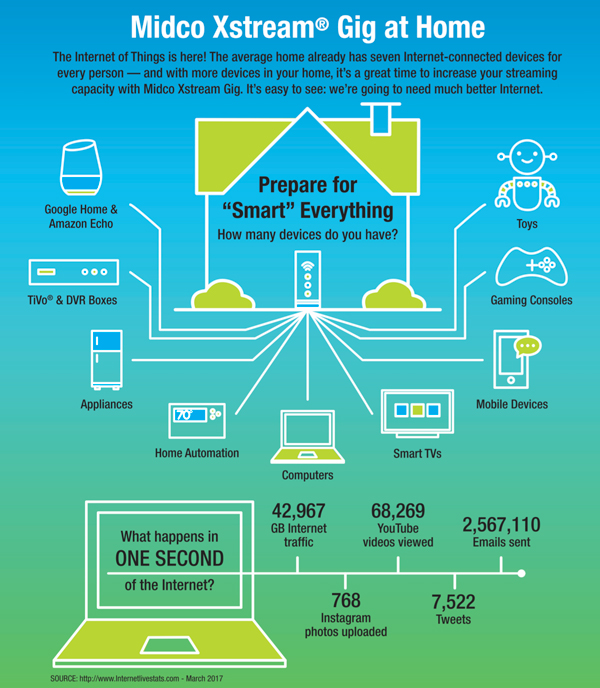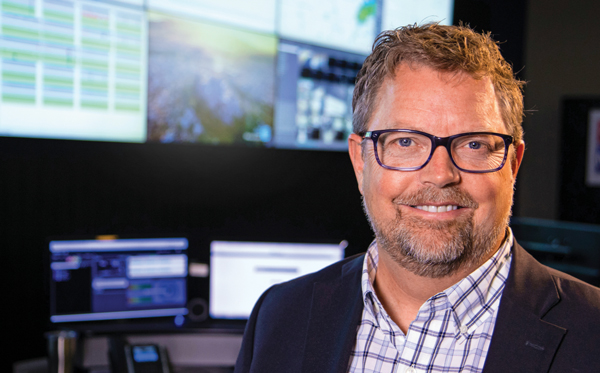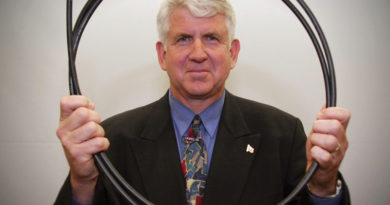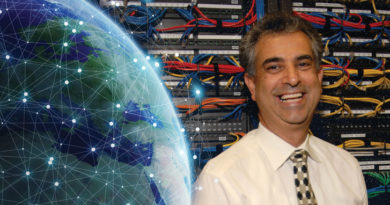Jon Pederson Gets the Gig
Midco’s CTO, Jonathan Pederson, is leading the Sioux Falls-based company into the technology big leagues with a network-wide DOCSIS 3.1 implementation, an eye toward IoT and a focus on cultivating innovation from within. Here’s how he sees a shifting technology landscape — and Midco’s role in it.
By Stewart Schley
You started college as a psychology major. Now you’re CTO of a prominent cable company. How did that path happen?
I got a job when I was going to college: a night computer operator. I learned I had an aptitude, and that I liked it. I switched to a tech school after that. At the time, Midco had a standing order with my school for an intern every year. It went to the top student in the class. Fortunately for me, that guy got a job. So I got an internship, unpaid, doing programming.
And later they offered you a job?
Pretty much. They didn’t have an actual job opening so I worked as a contractor for a while, and then was offered a job.
What was your impression about the cable industry at large and Midco in particular in the mid-1980s?
At that time we owned radio and TV stations and movie theaters, even then we had a focus on technology. Back then there weren’t a lot of mainframes; Midco was one of the companies that had one. So even though you have to adjust for time, we were pretty advanced. I was an IT guy. We supported all layers of business.
Did the outlook for cable seem bright?
I think so. Cable was still kind of new then. All the cool kids had cable. And at the time, we didn’t even comprehend the full potential; it was all about video service.
What was your path to becoming CTO?
As a company we’ve always progressed. And that means new things would come up. That’s where I gravitated. So whenever it was, ‘Do you want to stay here and do this, or do you want to try this new thing?’ I chose the new thing. You do that enough times and pretty soon you’re kind of making the new things happen. I guess that’s been my career path: do the new shiny thing and make it work.
What’s one example of a shiny new thing you got to help along?
Somebody had talked about this strange thing called a cable modem. I think we had the first cable modem test in the Midwest. I thought: This sounds interesting; I want to go learn all about this. So I became involved in that initial trial. Back in the day it was a clunky Zenith cable modem. But it worked. This was right at the start of bulletin boards — we had our own dial-up bulletin board — and our thought was, what if we could have a modem that would just stay dialed-up all the time? That’s when we started to see the potential of the cable network. I thought the ‘always-on’ element was bigger than speed, actually. It was funny, because at the time it felt like you were breaking the rules by leaving your modem ‘dialed up.’
What’s happening now with this ‘cable modem thing’?
We’re in the final stages of our gigabit/DOCSIS 3.1 rollout. It’s been really a massive project. From a technology point-of-view, we’re now on the backside of that. We’ve also had a number of acquisitions, so a lot of it is just dealing with volume: volume of Internet usage, volume of products.
When did you decide to make the leap to gigabit, and why?
Like everybody else, we were in a mode of having to do a lot of network upgrades and node splits, just kind of keeping up with this rapidly increasing demand. It was tiring. So we thought: Wouldn’t it be neat if we could kind of just jump ahead? Skip about eight upgrades and sort of just leap forward. A couple of things happened during that timeframe. One, people started talking about DOCSIS 3.1 at CableLabs. We began to understand this is new technology, and this really scales very well. We thought, this could be possible. The other thing was I started doing some tests regarding network traffic, and we found out that if you increase the bandwidth available to people, utilization doesn’t necessarily go up. In fact, it went down in 85% of our markets, as measured anyway. Because people get in and they get out faster.
And then the lightbulb went off?
It gave us the notion that if we could go to high speed, such as a gigabit — which at that point was sort of the grail — then it didn’t necessarily follow that utilization would just track right behind it. And so it seemed like a very achievable and scalable goal.
Where did you start?
The first thing you have to do with DOCSIS 3.1 is to clear out some spectrum for it. So that started about four years ago. And probably the last two years we’ve been pretty hot and heavy about replacing equipment.
What about the economics of DOCSIS 3.1?
We knew it was going to be expensive. But one of the specific reasons we chose DOCSIS 3.1 was because it was very much an investment in the future. It was kind of in the same vein as the saying ‘The best time to plant a tree is 20 years ago. The second best time is today.’ Not only was it getting us a more immediate solution to our bandwidth problem, it was also setting the stage for the future. That’s why we liked it. So in our case we were willing to invest to get to that position.
What are the challenges, even those not well appreciated, about making this significant of a transformation? What’s hard about DOCSIS 3.1?
I can think of three things. One is, in making that spectrum available, there are a lot of customer touches. We had to deploy DTAs [digital transport adapters], and it was a ton of work for our customer support people. The other one was, we were very early in the process, so we were ready to go and waiting for CMTSs and modems to come off the assembly line. We did some field trials and lab trials with Cisco, our vendor, and in the end we were waiting for modems. And the one that caught us a little bit by surprise: We had a pretty big impact to technical facilities. You’ve got a building you’ve been in for years, and all of a sudden you’re running a lot more bits through that building, and it’s equipment that requires more electricity and gets hotter, so you have to cool it. And you can’t pull out the old stuff and put in the new stuff. You have to put in the new at the same time. So we ended up having to do some facilities upgrades. They were inevitable anyway, but we had to pull them forward a year or two.
What do you see happening in the user marketplace that leads to demand for more bandwidth?
One of the things is, we’re seeing about a 45 percent CAGR in what people are doing on the Internet. So you always have to be out in front of that. A lot of that is from over-the-top video. Because of that it’s logical to assume more of our own video will move to the Internet side. With products like TV Everywhere, we’re already doing that. You’re also seeing the proliferation of devices in the home. It’s hard to predict what people will do, but they’re going to use that bandwidth. I think we’ll see a shift from a focus on speed to a focus on quality of network. It’s not just about a couple of devices in your home anymore. It’s almost about an entire network ecosystem that all gets along together.

What’s your early view on the Internet of Things as it relates to connectivity?
It’s a bit scary, but I think it’s mostly more of an opportunity. The cable industry has a handle on the technology, with CableLabs, and this is a very high priority for them. We’re staying very close to that. Another thing is we’ve joined the Open Connectivity Foundation, which is an organization that’s designed to get a handle on the Internet of Things, and provide some foundation for organization and standardization.
I think that very much addresses that concern. Because you’re going to have a thermostat from one vendor, a scale from another, a refrigerator from a third and a baby monitor that has poor security. That’s what we’re looking at. But I don’t think there’s anybody better positioned than us as an industry to clear that up and take advantage of it.
What’s happening with video over your network?
We’re contemplating a gradual move to IPTV as it makes sense. In our case, we’ve chosen to not embrace 4k and other advanced video options unless they’re on IP. So right now you can buy a 4k TV and go to Netflix and watch 4k video, or YouTube or a number of other sources, and our feeling is that’s where that increased quality is going to come from — an IP source. Because devoting more capacity on our video network would just take away bandwidth from broadband. Our focus is on keeping space for broadband.
What about the business side, from a network perspective?
One of the interesting things about business traffic is it actually doesn’t have a huge amount of impact, unless it’s wholesale. Because we always engineer to peak. That’s usually about 9 o’clock at night to 11 o’clock on the residential side. And that’s not really prime time for business. It’s more about upping the quality game on your network. Banks, for instance, tend to be pretty particular about their network connections. And the other thing is, when we look at expanding our network, sometimes business helps drive what towns we go into. At least they certainly add to the justification. Let’s say we’re in town and we have to make a run from fiber point A to B: if there’s a business three blocks away, we’ll alter to go to that business.
Where do you see opportunities for newcomers to the business today?
You always need technologists, and people who can speak the language of technology to people who don’t understand it as well. So I think there’s tons of opportunity there. I believe over time we’re going to take much more interest in the home network. Like I mentioned, it’s not four devices, it’s going to be 17 devices. And people can’t call the thermostat vendor to get good support. So if you’re able to provide great support for that by leveraging a fresh new workforce, that’s a very strong competitive advantage.
What’s fun about the job?
I like to build things. I’d say there’s nothing more satisfying than to build something that other people use. So what I find really gratifying is to find out that somebody in one of our cities is working for a big company in another state. And they’re able to do that because of the great connection you provide. Or they started a company, or you’re providing service to a business incubator. It’s fun to be an enabler and an energizer of other people’s efforts.
Where does innovation come from in your world?
We’ve actually just started an innovation program. The notion behind that is, if you look at Midco 10 years or 20 years ago, it was a different company. Part of the reason it’s different now is that things happened: cable modems, phone service, etcetera. We need to be surveying the technology for the next 10 years. We’re creating an innovation funnel to entertain those new ideas and figure out how business is going to transform in the future. We’re setting it up so that our best and brightest — if they come up with an idea or stumble upon an idea — it’s got a place to get vetted. Our methodology is like many others: It’s going to be ‘fail fast.’ So we’ll run it through the funnel and see if it’s something that has some potential. And if it does, then it gets routed to product development or it gets used as a new IT tool or something like that. Somebody once said, ‘Innovate or die.’ We’re implementing innovation in the best interest of our future.
So anybody can contribute?
I think it’s pretty important that you leave it open. If you’re a person with great ideas, and they seem to fit, it feels like the last thing we want to do is put constraints on that. You really want that sort of diversity of ideas. If it’s stuff you were going to think of already, then what’s the point, right? You want some of those ideas that come from left field.
Last question: What did you see at Cable-Tec Expo 2017 that was especially intriguing — and why?
First off, I think the show was great. We had an early remote PHY session whose unexpected attendance blew out the room. I also noted strong interest in DOCSIS 3.1 deployment experiences. It’s nice to see that sort of technical optimism and interest. One thing I found particularly interesting was the notion of a ‘virtual CMTS’ which is really a CMTS running on a server as software. Multiple vendors are in various stages of development. This is a major paradigm shift and finally brings to light a very applicable use case for the SDN/NFV stuff that everyone has been talking about for years. Combined with remote PHY, this has the potential to dramatically transform the cable network we know and love, while ensuring we continue to be the best network technology out there. I also was pretty intrigued by ‘DevOps,’ a software engineering practice that’s new to me, but widely used by some. This strikes me as being very disruptive to the IT world and something worth learning more about.
 About the Interviewer
About the Interviewer
Stewart Schley,
Media/Telecom Industry Analyst
stewart@stewartschley.com
Meet Stewart Schley, a journalist who is no stranger to broadband. For over 20 years Stewart has been captivating readers with his industry foresight and knowledge. He has a special talent for providing the best business profiles by sitting down… one on one… with his subject and getting the real story. If you missed his compelling interviews with John Malone, JR Walden or Peter Schultz, check them out at broadbandlibrary.com in the archives section.
Jonathan Pederson, Chief Technology Officer, Midco





Pingback: Okay, see it’s “gig” like a job, but also like, y’know, the Internet & stuff | Stewart Schley Content Services